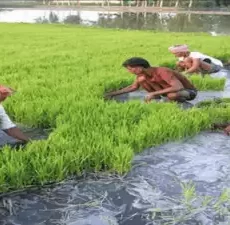In the last part of this series, we shall be talking about the last baby of the documentary – Hattie – and then concluding the series!
Hattie. This urban newborn is introduced to us embraced in the arms of her father. Next we see her being read to by her mother. Hattie is a city child who is usually surrounded by her parents. A prominent example of this is how Hattie was seen resting on a hanging support (from the ceiling) as her mother worked in the kitchen. The girl was almost never out of her parents’ sight. Happy Ho organizes best Meditation and Tarot classes in Noida and Delhi NCR area in India.
Hattie has all the luxuries of an American child – constant visits to the doctor to track her development, feeding via a bottle, bath in a tub or a shower, neat and warm clothes, bright and engaging toys. There was a scene which starkly showed the difference between Ponijao’s and her rearing. While Ponijao’s mother let him roll in the dirt all day, Hattie’s clothes were cleaned with a roller brush just because she was crawling on a carpet already being vaccuumed.
While Mari seemed to enjoy socializing with other kids, Hattie is shown trying to exit a room filled with her mother and other members of the mother-infant support group. This could be an undesired impact of Hattie constantly being surrounded by her parents only.
Hattie’s sensory, motor and cognitive capacities seemed to be extremely well developed. This was exhibited in a scene where she is seen holding a banana. Using her fine motor skills, Hattie starts peeling the banana and once she is done, she grabs a bite of the bitter end of the fruit. Here, using a combination of her tasting and cognitive abilities, she is able to first sense the bitterness and then compare it with the actual (or nicer) taste of a banana (she had previously). When she recognises the incongruence between the two, she takes out what she ate and grabs another bite from the banana. This time she can be seen relishing the fruit, which shows congruence between what tasts she expected of the banana and what she received.
Conclusion. Babies simply gets to the ground and explores the path that these four protagonists walk from birth to the first year of their lives. Instead of trying to determine the best path, it encourages us to keep our minds as open as Thomas Balmès’s lens and look at the delicate differences between each of them.



